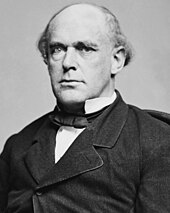| Chase Court | |
|---|---|
 | |
| December 15, 1864 – May 7, 1873 (8 years, 143 days) | |
| Seat | Old Senate Chamber Washington, D.C. |
| No. of positions | 10 (1864-1866) 8 (1866-1869) 9 (1869-1873) |
| Chase Court decisions | |
 | |
The Chase Court refers to the Supreme Court of the United States from 1864 to 1873, when Salmon P. Chase served as the sixth Chief Justice of the United States. Chase succeeded Roger Taney as Chief Justice after the latter's death. Appointed by President Abraham Lincoln, Chase served as Chief Justice until his death, at which point Morrison Waite was nominated and confirmed as his successor.
The Chase Court presided over the end of the Civil War and much of the Reconstruction Era. Chase was a complete change from the pro-slavery Taney; one of his first acts as Chief Justice was to admit John Rock as the first African-American attorney to argue cases before the Supreme Court.[1]
During Chase's chief-justiceship, Congress passed the Habeas Corpus Act 1867, giving the Court the ability to issue writs of habeas corpus for defendants tried by state courts. The Chase Court interpreted the Fourteenth Amendment for the first time, and its narrow reading of the Amendment would be adopted by subsequent courts.[2] As Chief Justice, Chase presided over the 1868 impeachment trial of President Andrew Johnson. He also pursued the presidency twice while in office; he unsuccessfully sought the Democratic presidential nomination in 1868 and the Liberal Republican nomination in 1872.
- ^ "The Impeachment of Andrew Johnson: Salmon Portland Chase". Impeach-andrewjohnson.com. Retrieved December 11, 2011.
- ^ Lurie, Jonathan (2004). The Chase Court: Justices, Rulings, and Legacy. ABC-CLIO. pp. 87–89. ISBN 9781576078211. Retrieved 9 March 2016.